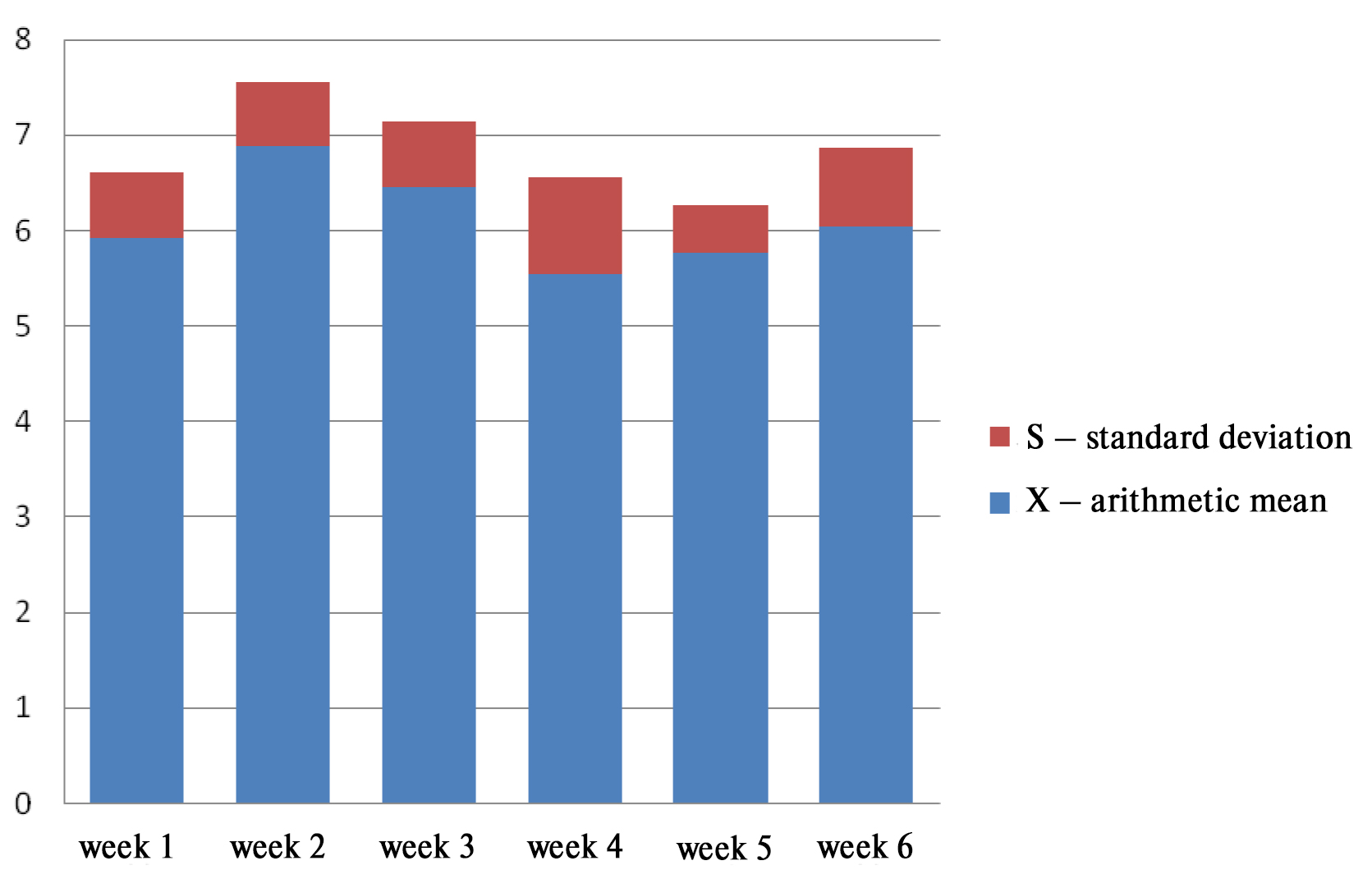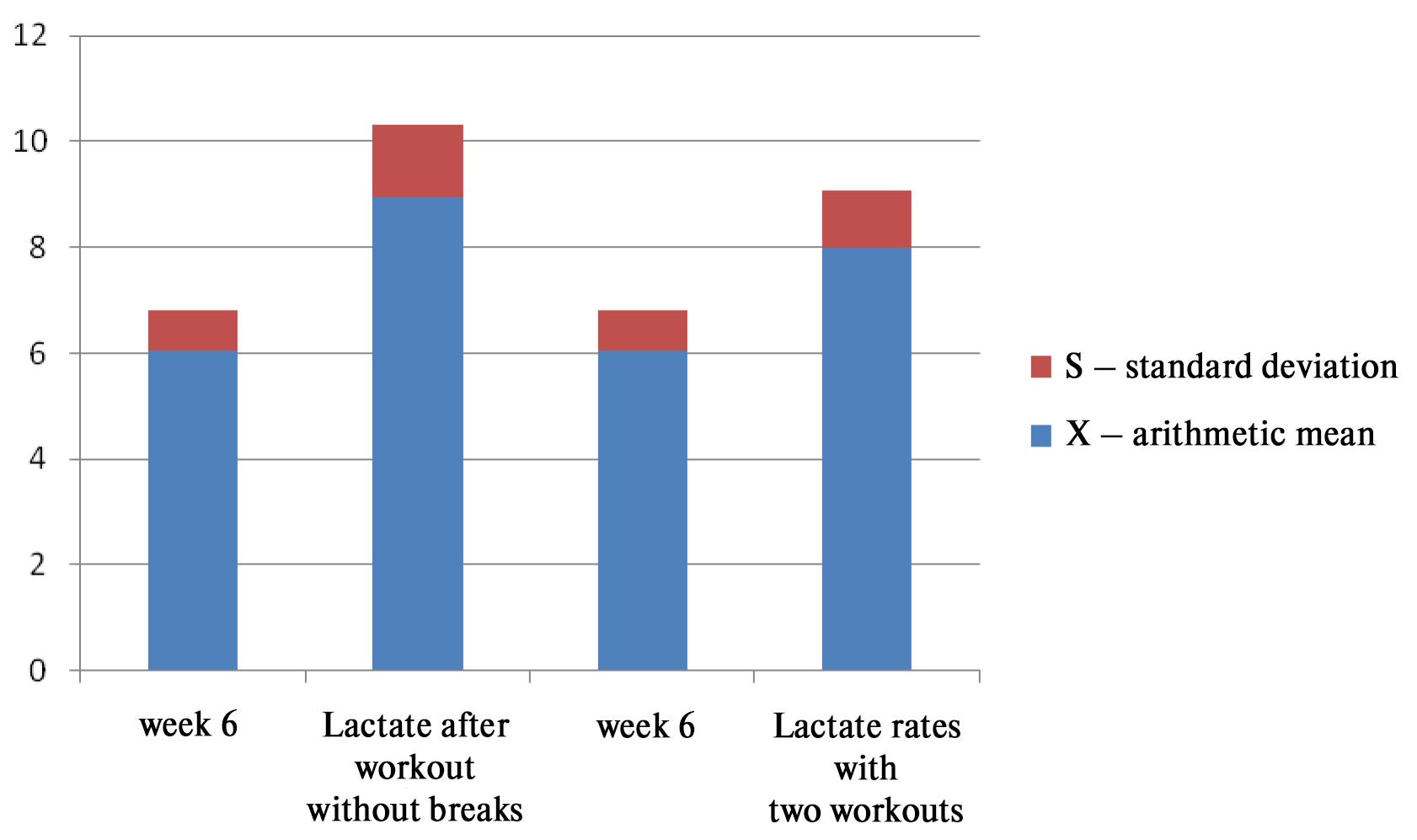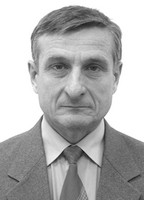Lactate dynamics in elite weightlifters during eight weeks of training
Фотографии:
ˑ:
Dr.Hab. I.P. Sivokhin1
Professor, PhD V.F. Skotnikov2
M. Tapsir3
Master, doctoral student O.Y. Komarov4
Associate Professor, PhD B.M. Utegenova1
Associate Professor, PhD A.I. Fedorov5
1Kostanay State Pedagogical Institute, Kostanay, Kazakhstan
2Russian State University of Physical Culture, Sport, Youth and Tourism, Moscow
3Management of the national teams, Astana, Kazakhstan
4Kazakh Academy of Sports and Tourism, Almaty, Kazakhstan
5South Ural State University, Chelyabinsk
Introduction. Increasing competition in modern sport requires further search for effective means and techniques of sport training and improvement of the quality of training process management (Hakkinen et al., 1987; Hakkinen et al., 1981). Analysis of the relevant literature revealed a number of contradictions between the desire for further improvement of the training programs for athletes and insufficient scientific data on the reaction of the athlete's body to training load (Komi, Hakkinen, 1989; Hakkinen, Komi, Tesch, 1981).
Biochemical control associated with the measurement of the lactic acid (lactate) concentration (Freund, Zoulowwmian, et al., 1992) which helps to estimate an individual load cost for the athlete's body after or during training is often used in sports to solve this problem.
Objective of the study was to analyze the lactate concentration dynamics in elite weightlifters during an eight-week training cycle.
Research methods and structure. Five (n=5) elite weightlifters bearing the title of Candidate Master of Sports were subject to the study. Special equipment of the Accutrend PlusandCobas brand (Germany) was used to determine lactate concentration in peripheral blood. The said equipment allows to assess the required parameters within a minute in a gym. Lactate was measured in millimoles per liter of blood. The blood test was carried out immediately after the workout. The study was conducted during 6 microcycles, each being a week long. A standard pilot program was carried out during the 7th week, but passive rest breaks 15-20 minutes long between the exercises were completely excluded. The second morning training was added on Monday, Wednesday and Friday during the 8th week that consisted of traditional exercises with a barbell of the weight of 70-85% of the maximum result while in the intensity zone. Blood sampling was carried out three times per week after the main training (Monday, Wednesday, Friday) that took place from 5 pm till 7 pm. The main load was performed in the following intensity zones of the maximum result by days of the microcycle: Monday – 80-95%; Tuesday – 70-85%; Wednesday – 80-90%; Thursday – 60-70%; Friday – 90-100%; Saturday – 75-85%. Athletes were allowed to rest for 15-20 minutes between the exercises.
The following statistical indicators were defined during the analysis: group mean – M, standard deviation – SD. The differences between average group lactate rates in a weekly microcycle were assessed by the Student’s t-test for dependent variables.
Research results and discussion. Values of the obtained indicators that reflect the lactate level in the blood of the subjects in each microcycle are presented in Table 1 and in the diagram in Figure 1. According to the lactate dynamics analysis during a 6-week training mesocycle in terms of group mean indicators for each week-long microcycle, the lactate rates were M=5.95 mmol/L on average during the first week, followed by an upward trend during the second and third weeks: M=6.89 and M=6.45 respectively. This is indicative of the accumulative effect of the impact the training load has on the athletes' bodies during the first three weeks of the mesocycle (Buss, Hakkinen, Komi, et al., 1992; Hakkinen, Komi, Alen, et al., 1988a; Hakkinen, Komi, Alen, et al., 1988b). A significant decrease in the average lactate rates to M=5.55 mmol/L was observed during the fourth week of the mesocycle. However, it increases slightly to M=5.76, M=6.05 mmol/L during the 5th and 6th weeks of the microcycle. This trend of the lactate dynamics presented in the diagram (Figure 1) reflects mainly the tendencies of adaptation of the athletes’ bodies to the training load of the speed and strength type (Buss, Hakkinen, Komi, et al., 1992; Hakkinen, Komi, Alen, et al., 1988a; Hakkinen, Komi, Alen, et al., 1988b). A decrease in lactate after three weeks of high-intensity training may indicate an increase in the ATF and PCr content in the athletes' bodies, as evidenced by scientific findings of other researchers (Jansen, 2006).
Table 1. Peripheral blood lactate dynamics in a 6-week training mesocycle of elite weightlifters (mmol/L) (n=5)
|
Weeks |
Weeks 1 |
Week 2 |
Weeks 3 |
||||||
|
Subjects/date |
19 12 |
21 12 |
24 12 |
27 12 |
22 01 |
25 01 |
29 01 |
30 01 |
01 02 |
|
1. G - v (mmol/L) |
5.5 |
6.1 |
6.0 |
6.5 |
6.6 |
6.9 |
6.2 |
6.5 |
5.6 |
|
2. K – v (mmol/L) |
6.6 |
6.4 |
7.0 |
7.6 |
8.1 |
7.5 |
7.9 |
8.0 |
6.1 |
|
3. Zh – iy (mmol/L) |
5.4 |
5.2 |
5.2 |
6.0 |
7.6 |
7.9 |
7.0 |
7.3 |
5.7 |
|
4. P – v (mmol/L) |
5.6 |
5.3 |
5.1 |
6.1 |
6.3 |
7.1 |
6.0 |
6.5 |
6.0 |
|
5. M – n (mmol/L) |
6.0 |
7.3 |
6.2 |
5.8 |
6.2 |
7.2 |
5.9 |
6.3 |
5.8 |
|
Statistical indicators: |
M=5.92 SD=0.69 |
M = 6.89 SD=0.67 |
M=6.45 SD=0.69 |
||||||
Table 1 continued
|
Weeks |
Week 4 |
Week 5 |
Week 6 |
||||||
|
Subjects/date |
04 02 |
06 02 |
08 02 |
09 02 |
18 02 |
19 02 |
20 02 |
25 02 |
27 02 |
|
1. G - v (mmol/L) |
5.2 |
4.6 |
5.6 |
5.0 |
5.3 |
5.2 |
4.4 |
6.1 |
4.9 |
|
2. K – v (mmol/L) |
5.3 |
7.3 |
4.7 |
6.4 |
6.8 |
6.2 |
6.6 |
7.1 |
6.2 |
|
3. Zh – iy (mmol/L) |
5.7 |
5.9 |
8.2 |
6.0 |
6.6 |
5.8 |
7.3 |
6.8 |
5.8 |
|
4. P – v (mmol/L) |
5.5 |
5.2 |
4.9 |
5.5 |
5.8 |
5.3 |
5.5 |
6.2 |
5.5 |
|
5. M – n (mmol/L) |
5.1 |
5.4 |
4.7 |
5.9 |
5.5 |
5.2 |
5.9 |
6.5 |
5.9 |
|
Statistical indicators: |
M=5.55 SD=1.00 |
M=5.76 SD=0.51 |
M=6.05 SD=0.78 |
||||||
Increased lactate in the subjects during the 5th and 6th weeks may indicate activation of fast motor units as well as selective hypertrophy in fast muscle fibers as a result of muscular and nervous conditioning factor adaptation to the physical load (Hakkinen et al., 1987; Seluyanov, 2001; Hakkinen, Komi, Kauhanen, 1986).

Figure 1. Peripheral blood lactate dynamics (mmol/L) in the elite weightlifters' training mesocycle (n=5)
The main goal of weight training is activation of creatine phosphate mechanisms of energy supply without excessive accumulation of lactic acid which should not exceed 6-8 mmol/L (Jansen, 2006). According to some data PCr production slows down if lactate is high. This leads to a decrease in operation power and reduced specific orientation of the training load (Jansen, 2006).
High lactate concentration as well as its extended presence in the muscle cells lead to extensive destruction of cell structures and membranes. Scientific evidence suggests that this leads to a deterioration in the recovery process and suppression of the process of structural proteins synthesis including that of myofibrils (Seluyanov, 2001; Ivanov, Korovkin, Pinaev, 1977). Taken together, this reduces the training effect of the physical load. However, in the elite weightlifters' training practice very high training loads are often used accompanied by an increase in group mean lactate values of up to M=14.9 mmol/L, SD=1.8 (Korzhenevskiy, et al, 2012).
In order to eliminate the side effect associated with the overaccumulation of lactate an intensive 20-25 minute workout should be done during the training of weightlifters, followed by breaks of passive 15-20 minute rest for the lactic acid to be utilized and the muscle contraction creatine phosphate mechanism of energy supply to be restored (Sivokhin, 2009). Large volumes of high-intensity training can be achieved by increasing the number of workouts up to two-three throughout the day. To eliminate the lactate overaccumulation periods of passive rest between exercises 15-20 minutes long need to be included (Sivokhin, 2009). This time is enough to decrease the lactate level by 50-60% (Sivokhin, 2012).
An additional experiment was conducted for experimental validation and confirmation of the methodological approaches data with the same subjects as participants. A standard pilot program was carried out during the 7th week, but passive 15-20 minute rest breaks between the exercises were completely excluded. The second morning training was added on Monday, Wednesday and Friday during the 8th week that consisted of traditional exercises with a barbell of the weight of 70-85% of the maximum result while in the intensity zone. The main results of the study presented in Figure 2 showed that the training load without passive rest between exercises causes a sharp lactate rise in the athletes up to M=8.95 mmol/L, SD=1.37, which is higher than the value of the 6th week by 2.90 mmol/L (P<0.001). This indicates a shift in the muscle contraction energy supply mechanisms towards the lactate or anaerobic glycolytic zone and causes excessive lactate accumulation which can lead to suppression of alactic energy supply mechanisms (Jansen, 2006).

Figure 2. Lactate group mean values (mmol/L) during the 6th week, in the microcycle with passive rest between exercises excluded (the 7th week) versus the one with two workouts a day (the 8th week).
The training load with the inclusion of the second workout per day had significantly increased the lactate levels in athletes too – up to M=7.99 mmol/L, SD=1.08, which is higher than those of the 6th week by 1.94 mmol/ (P<0,001). According to the findings, athletes who are more fit for the training load have their lactate levels raised after the second workout is added, which indicates an increase in the physiological load on the creatine phosphate system of energy supply. The increase in physiological load on the creatine phosphate system of energy supply can be considered a factor of influence on the growth of the capacity and power of these mechanisms. There is a fundamental relationship in a muscle cell which is that with the increase of the total amount of creatine the amount of actin, the contractile protein, in myofibrils increases. The amounts of actin and ATF activity, in their turn, have an impact on the power and strength of the muscle contraction, which determines the performance in speed-strength-intensive sports including weightlifting (Menshikov, Volkova, 1986).
Conclusion. The study showed that biochemical control of the lactate dynamics is a sensitive indicator of the athletes’ bodies’ reaction to the training load and can be used to control the training process in weightlifting. The study provided new information about the processes that occur in the athletes' bodies impacted by the training load of speed and strength type. Such data provide an opportunity to assess various components of the training load and ensure further improvement of various models of the training process.
References
- Buss O.T., Hakkinen K., Komi P.V.. et al. (1992). Hormonal adaptations and modeled responses in elite weightlifters during 6 weeks of training. European Journal of Applied Physiology, 381–386.
- Freund H., Zoulowwmian P., et al. (1992). Lactate kinetics after maximal exercise in man. Medicine of Sports Science, 17, 9-24.
- Hakkinen К., Kauhanen H., Kuoppala Т.К. (1987). Neural, muscular and hormonal adaptations, changes in muscle strength and weightlifting results with respect to variations in training during one year follow-up period of Finnish elite weightlifters. World weightlifting, Scientific supplement, 3, 2-5.
- Hakkinen, К., Komi, P. V.,Tesch, P. (1981). Effect of combined concentric and eccentric strength training and detraining on force-time, muscle fiber, and metabolic characteristic of leg excensor muscles. Scandinavian Journal of Sports Sciences. 3. 2, р. 50-58.
- Hakkinen K., Komi P.V., Tesch P. (1981). Effect of combined concentric and eccentric strength training and detraining on force-time, muscle fiber, and metabolic characteristic of leg extensor muscles. Scandinavian Journal of Sports Sciences, 3, 2, 50–58.
- Hakkinen K., Komi P.V., Alen M. et al. (1988a). Relationship between training volume, physical performance capacity and serum hormone concentrations during prolonged training in elite weightlifters. International Journal of Sports Medicine, 61–65.
- Hakkinen K., Komi P.V., Alen M. et al. (1988b). Daily hormonal and neuromuscular responses to intensive strength training in 1 week. International Journal of Sports Medicine, 422–428.
- Hakkinen K., Komi, P.V., Kauhanen H. (1986). Electromyographic and force production characteristics of leg extensor muscles of elite weightlifters during isometric, concentric and various stretch-shortening cycle exercises. International Journal of Sports Medicine, 7, 3, 144–151.
- Ivanov I.I., Korovkin B.F., Pinaev G.P. (1977). Biokhimiya myshts [Biochemistry of muscles]. Moscow: Meditsina publ., 343.
- Komi P.V., Hakkinen K. (1989). Strength and power. Proceedings of the weightlifting symposium. Siofok, Hungary, 159-175.
- Korzhenevskiy A.N., et al (2012). Kompleksnaya diagnostika podgotovlennosti vysoko-kvalifitsirovannykh tyazheloatletov [Complex diagnostics of fitness of elite weightlifters]. Teoriya i praktika fiz. kultury, 12,26-32.
- Menshikov V.V., Volkov N.I. (1986). Biokhimiya: Uchebnik dlya institutov fizicheskoy kul'tury [Biochemistry: Textbook for institutes of physical culture]. Moscow: Fizkultura i sport publ, 384.
- Seluyanov V.N. (2001). Podgotovka beguna na srednie distantsii [Training of middle-distance runner]. Moscow: SportAkademPress publ., 104.
- Sivokhin I.P. (2009). Analiz effektivnosti trenirovochnogo protsessa v godichnom tsikle podgotovki tyazheloatletov natsional'noy sbornoy RK [Analysis of training process efficiency in annual training cycle of national weightlifting team of Kazakhstan]. Teoriya i metodika fizicheskoy kultury, 1, 155-164.
- Sivokhin I.P., Ageev O.V., Orekhov L.I., Khlystov M.S., Ni A.G. (2012). Izmenenie laktata na trenirovochnuyu nagruzku v mikrotsikle podgotovki tyazheloatletov [Changes in lactate under training load in training microcycle of weightlifters]. Teoriya i metodika fizicheskoy kultury, Almaty, 2 (29), 68-73.
- Jansen P. (2006). ChSS, laktat i trenirovki na vynoslivost [Heart rate, lactate and endurance training] Transl. from Engl. Murmansk: Tuloma publ, 160.
Corresponding author: fizkult@teoriya.ru




 Журнал "THEORY AND PRACTICE
Журнал "THEORY AND PRACTICE